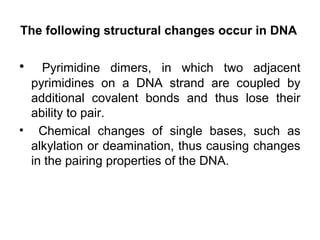Mutation
- 1. Mutation
- 2. • An inheritable spontaneous deviation from the “wild type” is called “mutation” and the organism in which it occurs is called a “mutant”. • Genetic recombination cannot create new alleles in the first instance: the ultimate source of all genetic variation is mutation.
- 3. • Mutations are caused by alterations in the structure, arrangement or quantity of DNA. Characteristically they are random (almost), rare, recessive, and harmful.
- 4. Chromosome mutations • Chromosome mutation may change the order of the genes within the chromosome, e.g., by deficiency, deletion, inversion, duplication, or translocation. Gene or point mutations may result from changes in the base sequence in a gene.
- 5. Mutations caused by changes to ploidy level Changes in the number of chromosomes can also cause mutation.
- 6. Aneuploidy • Gain/loss of individual chromosome, from a set. There are several reports of aneuploids in salmonids. • E.g., a male brook trout that was trisomic for a chromosome carrying a LDH-B enzyme locus was reported.
- 7. 1.Nullisomics (2n-2) - both of a pair of homologous missing from a diploid set 2.Monosomics (2n-1) - one chromosome from a diploid set missing. 3.Trisomics (2n+1) - one extra chromosome.
- 8. Chromosomal aberration • Four main types of chromosome aberrations are known. • Deletion– Fragment of chromosome is missing • Duplication – Fragment of chromosome becomes duplicated.
- 9. • Inversion – Fragment detaches and reinserts in the reverse order • Translocation – A segment from one chromosome becomes connected to a non homologous chromosome.
- 10. Inversions can be classified into two main types. • Paracentric inversions which do not involve the centromeric regions are difficult to detect. • They do apparently occur in fishes quite frequently, but their presence can only be established by analyzing the inheritance of the linked genes.
- 11. Pericentric inversions • Pericentric inversions involving the centromere are quite frequent. If the two breakage events take place at equal distances from the centromere one cannot detect the inversion without the analysis of marker genes. • • When the sites of breakage are located asymmetrically, the relative length or even the absolute number of chromosomal arms will be changed.
- 12. Gene Mutations • Gene mutations are broadly of the following types. • Substitutions. • Tautomerism.
- 13. • A transition is an exchange of a purine with another purine or a pyrimidine with another pyrimidine. • A transversion refers to the substitution of a pyrimidine with a purine or vice versa. • Tautomerism Like many organic molecules, the bases may change their shape (isomerism).
- 14. The following structural changes occur in DNA • Pyrimidine dimers, in which two adjacent pyrimidines on a DNA strand are coupled by additional covalent bonds and thus lose their ability to pair. • Chemical changes of single bases, such as alkylation or deamination, thus causing changes in the pairing properties of the DNA.
- 15. • Crosslinks between the complementary DNA strands, which prevent their separation in replication. • Intercalation of mutagenic agents into the DNA, causing frameshift mutations. • Single-strand breaks. • Double-strand breaks
- 16. Induced Mutation • Factors which cause mutations are called mutagenic agents or mutagens. A mutagen, by definition, is an agent which increases the frequency of mutation. • Mutation which occur at a frequency above the base (spontaneous rate) are described as induced.
- 17. The most well-known mutagens are • high energy irradiations, and • chemicals. High energy irradiations • These are the most frequent cause of mutation. • Most of the natural mutations are caused by cosmic rays from outer space and irradiations from radioactive elements.
- 18. • Mutations may be artificially induced in organisms by exposing them to X-rays, protons, neutrons and alpha, beta and gamma rays from radioactive sources such as radium, cobalt-60, etc.
- 19. Chemical mutations • A variety of chemicals are known which are mutagenic, and these may be classified into three groups according to their modes of action. • Mutagens which affect nonreplicating DNA. • Base analogs, which are incorporated into replicating DNA due to their structural similarity with one of the naturally occurring bases.
- 20. Induced mutations in fish • The frequency of mutations in fishes can be markedly increased by X-rays and chemical treatment • X-irradiation of fish gametes results in the appearance of various genic and chromosomal mutations • Chemical mutagens, particularly nitrosoethylurea (NEU) are highly effective in inducing mutations in fishes.




















